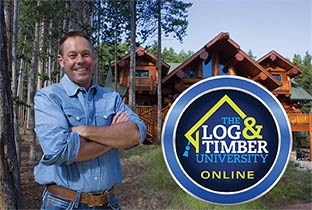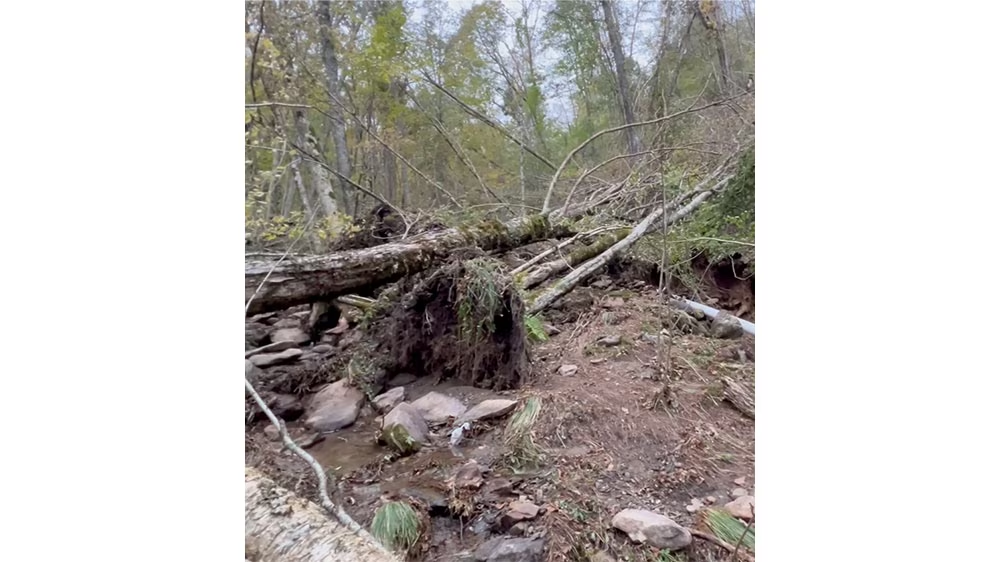
The view of Grandfather Mountain from the Elliotts' property.
For Charles and Tracy Elliott, building a log and timber home in the North Carolina mountains was the realization of a long-held dream. After two years of planning, saving and searching for the ideal property, they found an idyllic site in Banner Elk, with a breathtaking view of Grandfather Mountain and a peaceful creek winding through the landscape. Their vision was clear. They wanted a family retreat that could be passed down for generations and a place where their children, extended family and all future visitors could create lasting memories.
The Elliotts, originally from Texas and Florida, had spent much of their lives in Indianapolis, raising their two children in a bustling suburb that had grown rapidly over the years. With their son and daughter now in college, they felt the time was right to downsize and relocate to a quieter life in nature. The mountains of western North Carolina had long held a special place in their hearts. They were married in Asheville and had often returned to the area for vacations.
“We knew we wanted to be in a smaller town, somewhere peaceful but still with access to city amenities and outdoor activities,” Charles explains. “Banner Elk was perfect — mountain biking, hiking, fly fishing and even skiing in the winter but also close to the town of Boone. When we found our property, we knew it was the right spot.”
With their dream location secured, they began designing a home that would not only serve as a retreat for their family but also as a rental during ski season. They carefully considered details like a bunk room for visiting children, expansive outdoor living areas and flexible spaces that could adapt to future needs. Throughout their planning process, Log and Timber Home Living magazine played a vital role in shaping their expectations and decisions.
“We used the magazine as a resource to explore the building process, different home styles and the realities of constructing a log home,” Charles says. “The advertisers in the magazine also gave us a great starting point for researching suppliers.” With careful consideration, the Elliotts decided to work with Coventry Log Homes to build their dream home.

The front elevation for the Elliotts' log home.
However, the journey to their dream home took an unexpected and devastating turn in September 2024, when Hurricane Helene brought unprecedented storms and flooding to the region, washing away building materials and setting back their carefully laid plans. What followed was not just a story of loss, but one of perseverance, resilience and unwavering support from the log home community.
While hurricanes were nothing new to the Elliotts, both having grown up in coastal states, they never imagined the mountains would be vulnerable to such extreme flooding. As the reports on Hurricane Helene’s path became increasingly dire, Charles began to grow concerned, particularly about their builder’s warehouse, where many of their home’s materials were being stored.
“I checked the floodplain maps and saw that the warehouse wasn’t even in a 100-year flood zone,” he says. “No one expected what they ended up calling a ‘1,000-year flood.’”
As the storm made landfall, the damage became undeniable. Roads were washed away, power lines snapped like twigs and water carved new channels through the landscape. Charles knew that he had to get to the site immediately.
“When I saw a picture of a local garden center underwater, I knew our builder’s warehouse had to be flooded, too,” he recalls. “Driving there was surreal. Parts of entire roads were gone, and debris was everywhere. When I arrived, it was clear the warehouse and offices had been completely inundated with three sides of the building completely washed away.”

Stepping into the aftermath, the couple saw their construction materials scattered across fields, roadsides and even trapped under bridges. Logs, framing lumber and decking had been swept away, while windows had shattered upon impact with rocks and trees. Determined not to let the disaster derail their plans, he spent days retrieving whatever he could.
“We found logs as far as a half-mile away,” he says. “Some were stuck in collapsed buildings, while others were floating in fields. It was heartbreaking, but there was no time to dwell. We had to start reclaiming what we could and cleaning up the warehouse site."

He also was concerned for his builder, Copper Nail and their employees as they not only had to worry about damage to their business but damage to their homes and properties as well. Many of the subcontractors and other businesses in the trades also sustained significant damage.

Amid the losses, one discovery struck Charles particularly hard. A Cherokee marking tree, which stood for more than two hundred years, had been uprooted and destroyed.
“Down by the creek, there was a tree that the Cherokee had tied down in a certain way so that it would serve as a directional marker for scouts,” he explains. “These trees have an unnatural curve or bend, and they’re becoming increasingly rare to see upright. From the moment our neighbor pointed it out, we felt like it signified how special this area was. It struck me how this tree had managed to survive for so many years, yet it fell in this storm.”
The Elliotts weren’t alone in their struggle. As they worked to salvage their building materials, neighbors, local businesses and even strangers came forward to help. Recognizing the distinctive 8”x8” logs used for their build, people began returning them to the builder’s warehouse when they found them.

“The sense of community was incredible,” Charles says. “Everyone just did the best they could to help each other out. We also returned materials that belonged to others, like the garden center. It was about coming together in a time of need.”
Despite their best efforts, many materials were too damaged to use or had vanished entirely. That’s when their suppliers stepped in with unexpected generosity.
“Before I could even call Coventry Log Homes, Vice President Mark Elliot reached out to check on us,” Charles says. “There was no cell service at first, but once we finally connected, they were ready to help.”
Coventry is providing about 1,000 linear feet of replacement logs under cost. Additionally, they're precutting replacements for damaged or missing logs and shipping them for free. But the help didn't stop here.
Andersen and Coventry are working together to provide a roughly 75% discount to help offset the replacement of the windows. Sashco, the supplier of the finishes and stains for the home, also played a particularly crucial role. “Grizzly Bob” Kenel from Sashco not only provided expert guidance on how to clean the logs but also ensured they had the necessary supplies to do it right. Log Home Supply, based in Indiana, contributed cleaning materials and consulting. Lowe’s, where Charles and Tracy had purchased other building materials, offered to replace anything that had been damaged in the storm from their warehouse.
“I was amazed at how these companies stepped up,” Charles says. “They didn’t have to do it, but they did. It proved to us that the log home industry isn’t just about selling a product, it’s about people who truly believe in the lifestyle and community.”
For weeks, the rebuilding process was put on hold as emergency efforts took priority. Local authorities suspended new permits and halted construction as the community focused on clearing debris and restoring essential infrastructure. Once the new year arrived, the Elliotts were able to resume their build.
Charles, an Eagle Scout, had always believed in being prepared. He had kept meticulous records of their materials, and with the help of Coventry Log Homes, he painstakingly cataloged every recovered log in a spreadsheet to determine what still needed to be replaced.
“This experience reinforced just how important it is to have contingencies in place,” he reflects. “You have to expect the unexpected. Storing materials properly, having a complete inventory and knowing where everything comes from. Those things made a huge difference in getting us back on track.”
The creek on the Elliotts' property before Hurricane Helene.
When complete, this cabin and the surrounding mountains and valleys will have a story to tell. Helene left an indelible mark Western North Carolina, but one that Charles believes will be a source of strength as the recovery finishes.
“Our creek is in an ancient boulder field that has seen millions of years of weather,” Charles says. “This event has certainly made us respect these mountains.”
See also: Pro Tips for a More Resilient Log Home







